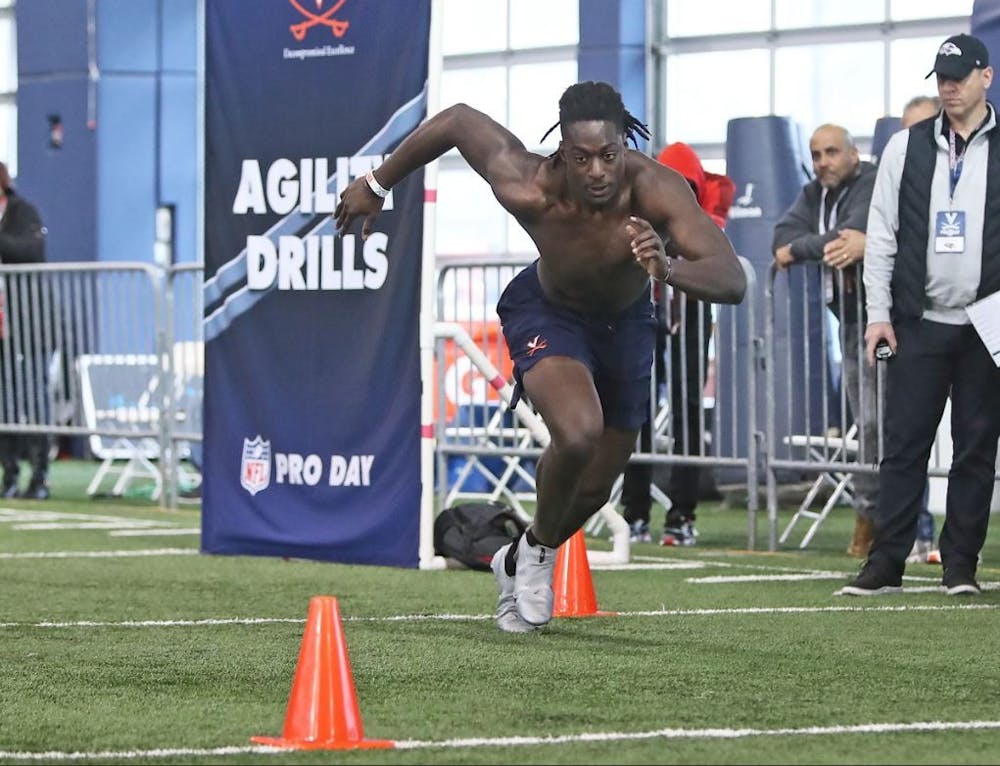The National Football League Combine can make or break a player’s stock heading into the draft. The event is an opportunity for the prospects to show their athleticism and skill set that may not show up on tape — Virginia’s graduate student tight end Jelani Woods did just that.
Woods ran a 4.61 second 40-yard dash, the second fastest time of the tight ends at the 2022 Combine and the fastest time ever for a tight end over 6-foot-7 since 2003. The Oklahoma State transfer also led all tight ends in the bench press, hitting 24 repetitions. Social media exploded after his performance, with the NFL reposting the video of his performance on Twitter.
The tight end continued his impressive pre-draft performance at Virginia's NFL Pro Day in mid-March, recording 4.2 seconds in the 20-yard shuttle, 6.78 in the Three-Cone Drill, 10.75 feet in the broad jump, and 37.5 inches in the vertical jump. All of these results would have led the tight end group in each category if he performed the events at the combine.
Woods’ draft stock has significantly risen after his impressive performances. In January, Pro Football Focus ranked him as the 171st best player in the draft class. Post-combine, it has risen to 141st. Joe Marino of The Draft Network listed Woods as a sixth to seventh round selection after the season, but the website now has him valued as a fourth rounder.
Seen at the time as a pure blocking tight end, Woods was not expected to be drafted following his 2020 season with Oklahoma State, amassing eight catches for 129 yards that season, a career high in college for him. However, transferring to Virginia for a graduate season changed the narrative about Woods completely. The tight end finished with 598 yards on 44 receptions in the 2021 collegiate season with Virginia, earning Woods an invite to the 2022 East-West Shrine Bowl — a showcase for college players in front of NFL scouts. The former high school quarterback’s potential is now being discussed in part because of the raw athleticism he displayed and because of how effective Woods was being utilized as a pass-catcher for the first time in his career.
The draft projections for Woods are all over the board. Draft analyst Todd McShay lists the Virginia product as a third to fourth rounder after the Pro Day. As mentioned before, PFF currently ranks Woods as the 141st player in the draft class, which places him in the fourth round, while The Draft Network has Woods listed at 120th. However, team-geared draft profiles such as Big Blue View names Woods as a day-two talent, meaning a second to third round pick. A recent mock draft by Pro Football Network has Woods getting selected by Kansas City at 94th in the third round. A four-round mock draft by NFL.com released Friday had Woods going in the second round to the Bengals at pick 63. Essentially, it’s possible Woods goes anywhere from the late-second to the fifth round, with a strong possibility of being a third or fourth round pick. While it is a big range, this uneasiness about his position can help Woods get drafted earlier. With significant uncertainty surrounding a player, teams do not know exactly what another staff’s evaluation of that player may be, potentially pushing the player further up draft boards.
Athleticism can make NFL teams fall in love with players and want to draft them earlier than expected. This can create a domino effect where another team will draft the player earlier to avoid the risk of losing the player. Woods’ situation is similar to the case of 2019 tight end prospect Kahale Warring from San Diego State. Warring was viewed as a later-round prospect after the 2018 collegiate season but impressed the media and scouts at the combine, leading to him being drafted in the third round by the Texans, which was still earlier than predicted. It’s likely that, because of Warring’s stock unpredictability, the Texans decided to pull the trigger in the third round in case another team had him as high as they did. Due to Woods’ intangibles and unpredictability about stock, it is likely he will end up in the same position as Warring.
Another factor to consider is the other tight ends in the class. Overall, it’s not an exciting class. The unanimous number one tight end, Colorado State’s Trey McBride, is expected to go in the second round rather than the first. Despite the lack of first-round talent, there is depth in the class which could hurt Woods as there are multiple tight ends seen to have a similar level of talent as Woods such as Washington’s Cade Otton and Texas A&M’s Jalen Wydermyer. That being said, Woods is considered to be the most athletic tight end in the class which separates him from the group.
Considering his ascension after his Combine and Pro Day performances, as well as the rest of the tight end class, it’s likely that Woods will be a third round pick later this April — an impressive feat considering he was expected to be a late-round pick before the NFL Combine and East-West Shrine Bowl.







